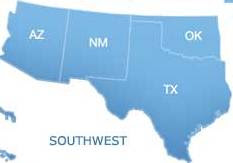A primary care health professional shortage area (HPSA), as designated by the Health Resources and Services Administration (HRSA), is geographic area, population group, or facility where residents have bad access to basic medical care. This designation reflects the fact that given the population size of the HPSA, there are too few primary care physicians serving the community. As of March 31, 2025, HRSA data showed that more than 77.2 million Americans lived in a primary care shortfall area, including over 10.8 million residents of the four-state Southwestern U.S. The HRSA estimates that to eliminate the primary care shortfall in the Southwestern U.S., HPSAs in the region would need over 1,900 additional primary care physicians. A closer review of March 31, 2025, HRSA data reveals the following about the primary care shortfall in the Southwestern U.S.:

|
The Primary Care Shortfall in the Southwestern U.S. |
|
| State |
(1) HPSAs |
(2) Population |
(3) Shortfall |
| AZ |
215 |
2,285,336 |
493 |
| NM |
106 |
1,027,943 |
200 |
| OK |
190 |
1,225,098 |
297 |
| TX |
387 |
6,278,102 |
916 |
|
|
|
|
| Region |
898 |
10,816,479 |
1,906 |
|
|
|
|
| U.S. |
7,749 |
77,253,848 |
13,364 |
(1) HRSA-designated Geographic Units, Population Groups, and Facilities with a primary care shortfall
(2) Population of designated HPSAs
(3) Primary Care practitioners needed to remove the HPSA Designation
Source: Designated HPSA Quarterly Summary, 3/31/25 (HRSA)

No comments:
Post a Comment
Let us know what you think about today's commentary!